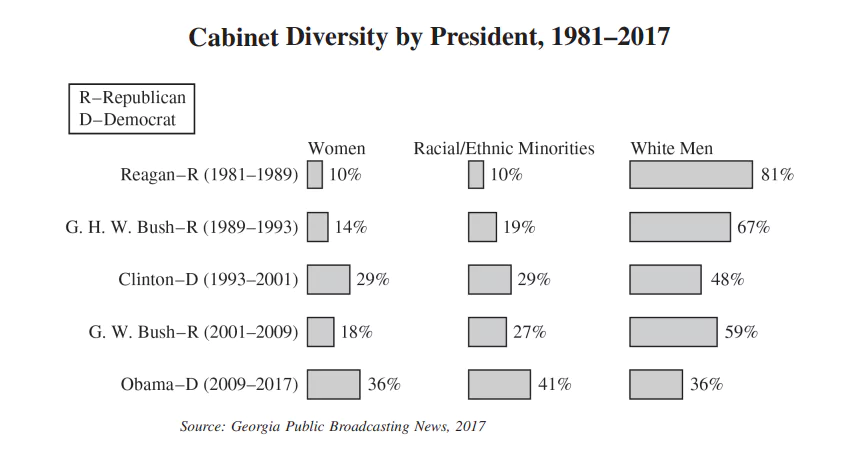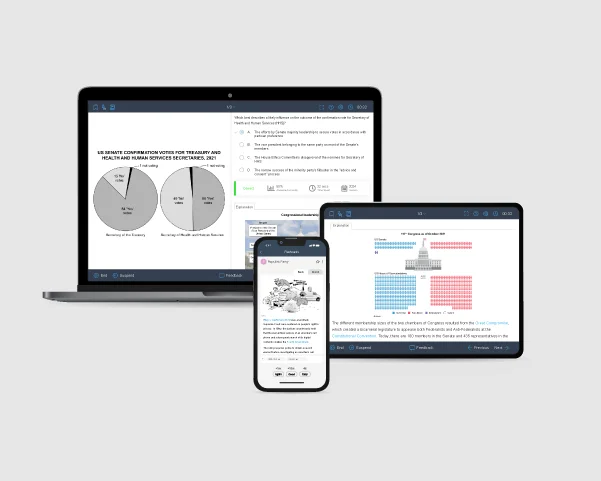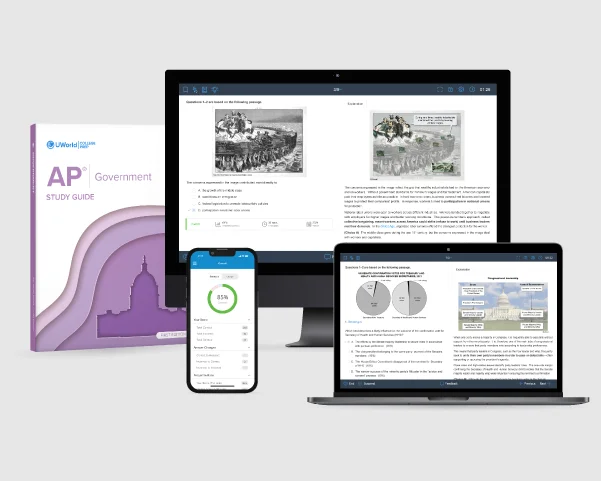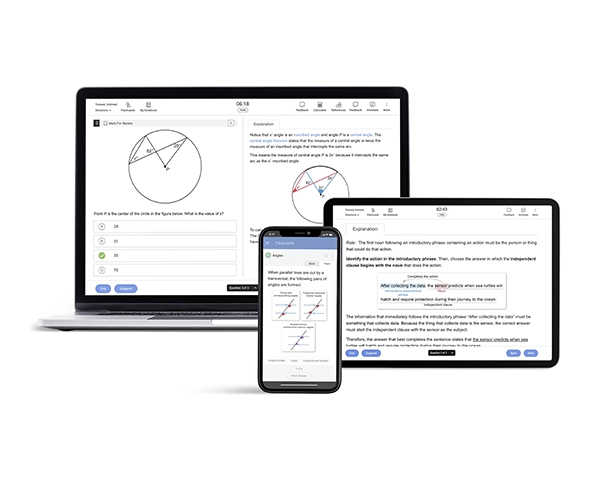Format of the AP U.S. Government FRQ section
Section II consists of four FRQs you need to answer in 100 minutes (1 hour and 40 minutes) and is worth 50% of your overall exam score (1 FRQ is worth 12.5%). Each AP Gov FRQ in this section tests you on specific practices and skills you’re expected to master by the end of this course.
Remember to plan your time wisely when practicing for the AP U.S. Government FRQ section. You’ll need time to read and understand what the question is asking, analyze the information given, then provide your answer with evidence, as-needed. It's important to create a plan for each FRQ that allows for enough time to read the question, plan your response, write it down, and then review it.
The table below describes each type of AP Gov FRQ and what is required in each response. To make time management easier for you, we’ve also included the approximate time you should allot for planning, writing, and reviewing each FRQ.
| FRQ Type | Description | Recommended time per FRQ |
|---|---|---|
| Concept Application (3 points) |
Explain the effects of a political/government institution, behavior, or process. Apply your understanding of course concepts in the context of an authentic scenario. | 15 mins planning and writing 5 mins reviewing/rewriting |
| Quantitative Analysis (4 points) |
Describe the relevant data provided to you, along with a conclusion you have drawn from an identifiable pattern or trend in the data. Then apply your interpretation of the data in the context of a political concept. | 15 mins planning and writing 5 mins reviewing/rewriting |
| SCOTUS Comparison (4 points) |
Describe and then compare or contrast case facts and holdings of a provided non-required case with those of a specified required case. Apply the non-required case’s holding in the context of a course concept. | 15 mins planning and writing 5 mins reviewing/rewriting |
| Argument Essay (6 points) |
Make and defend a claim in response to a prompt, citing evidence from at least one foundational document and your course knowledge. Establish reasoning to support your claim and to refute/rebut an alternate claim. | 30 mins planning and writing 10 mins reviewing/rewriting |
How to Answer AP U.S. Government and Politics Free-Response Questions
Here are some general tips for how to answer AP U.S. Government FRQs:
-
Start with the prompt that seems easiest
Starting with the easiest question can boost your confidence on the exam. Quantitative Analysis is the easiest for some students because it does not require them to read documents to answer the question. The Concept Application is easier for other students because it is less complex. Many students choose to answer the Argument FRQ last because it is the only one that requires an essay format.
-
Use evidence from the stimulus to support your interpretation
To score well on the FRQs, ensure you include paraphrased references to evidence from the stimulus materials. Focus on specific words and details that support what you have to say. For the Concept Application and SCOTUS comparison FRQs, refer to details from the provided scenario and Supreme Court case, respectively. For the Quantitative Analysis, identify specific data points and/or trends. Lastly, incorporate specific evidence from a foundational document and your course knowledge for the argument essay. For each FRQ, explain how the evidence supports your response.
-
You do not need to earn every point to score well
Each AP U.S. Government FRQ is worth multiple points. Simpler tasks, like identifying, earn points, just as more complex tasks, like refuting opposing claims, earn points. Even if you have difficulty completing a FRQ, you can score well by completing as many parts as possible.
-
Don’t worry too much about making spelling, punctuation, and grammar mistakes
The scorers understand that you are writing under a time limit and that your FRQ is more like a rough draft. If you make a mistake or change your mind, simply draw a line through the mistake and keep going.
AP United States Government and Politics FRQ examples
Here are some AP Government FRQ examples from past exams to give you an idea of the kinds of questions you’ll see on the test. These questions come directly from the College Board Course site, an excellent source of course materials. Each tab explains one type of AP Government FRQ examples and discusses the key points you need to consider while approaching them.
For FRQ 1, you will be given a brief account of a real-life scenario. You will demonstrate your understanding of the scenario by describing some aspects in the context of a course concept. You will then demonstrate a more expansive understanding of the course concept by explaining it further and applying it in a hypothetical situation.
FRQ Example 1
In April of 2018, Mark Zuckerberg, the founder of the social media company Facebook, was called to testify before the Senate Committee on the Judiciary and the Senate Committee on Commerce, Science, and Transportation about, among other things, a data leak that led to 87 million Facebook users' private information being sold without their consent.
Senators questioned Zuckerberg about whether Facebook could adequately regulate itself and protect personal information or whether Congress should intervene. Zuckerberg defended the company, emphasizing its mission to better connect the world. In response, Zuckerberg stated, "My position is not that there should be no regulation. I think the real question, as the Internet becomes more important in people's lives, is what is the right regulation, not whether there should be or not."
After reading the scenario, respond to A, B, and C below.
- Referencing the scenario, describe the enumerated power in Article I of the Constitution that gives Congress the authority to regulate a business like the one above.
- Explain how the two-chamber structure of the legislature affects the ability of Congress to exercise the power described in Part A.
- If Congress decides to regulate how social media companies gather and use the data of their users, explain how these companies could use the political process to ensure that the new regulation does not negatively affect them.
Source: College Board
For FRQ 2, you will be given relatively current data to interpret. You will be asked to draw conclusions based on patterns or trends you identify in the data and then apply your interpretation of the data in the context of a course concept.
FRQ Example 2

Use the bar graphs to answer the following questions.
- Identify the president who had the highest percentage of women and racial/ethnic minorities serving in the Cabinet
- Describe a pattern in the percentage of racial and ethnic minorities serving in Cabinet positions.
- Draw a conclusion about the political parties and the diversity of Cabinet appointments as shown in the bar graphs.
- Explain how interest groups can influence presidential Cabinet appointments as shown in the bar graphs.
Source: College Board
For FRQ 3, you will be given a description of a non-required Supreme Court case. The description includes relevant case background information along with some details about the Court’s holding. First, you will identify and describe a course-relevant similarity or difference between the non-required case and a specified required SCOTUS case. Then you will explain the similarity or difference in terms of how it is applied in both cases—this is essentially an exercise in comparing/contrasting. Finally, you will apply a relevant aspect of the non-required case in the context of an essential course concept.
FRQ Example 3
This question requires you to compare a Supreme Court case you studied in class with one you have not studied in class. A summary of the Supreme Court case you did not study in class is presented below and provides all of the information you need to know about this case to answer the prompt.
McCutcheon v. Federal Election Commission (2013)
Alabama businessman Shaun McCutcheon contributed $33,088 to sixteen different candidates running for federal office in 2012. His donations exceeded the aggregate (total) campaign finance limit established by the Bipartisan Campaign Reform Act (BCRA) of 2002. This law limited the total amount of political contributions that an individual could make in a given two-year election period to federal candidates, federal political action committees, and political parties.
In the subsequent case, McCutcheon v. Federal Election Commission (2013), the Court ruled in a 5-4 decision that limits on the amount of political contributions established by the BCRA are unconstitutional. The Court held that contributing money to a candidate is an exercise of an individual's right to participate in the electoral process.... A restriction on how many candidates and committees an individual may support is hardly a modest restraint on those rights. The government may no more restrict how many candidates or causes a donor may support than it may tell a newspaper how many candidates it may endorse."
- Identify the civil liberty that is common in both Citizens United v. Federal Election Commission (2010) and McCutcheon v. Federal Election Commission (2013).
- Explain how the decision in Citizens United v. Federal Election Commission relates to the reasoning in McCutcheon v. Federal Election Commission.
- Explain how the decision in McCutcheon v. Federal Election Commission can be used to support the participatory, pluralist, or elite model of democracy.
Source: College Board
FRQ 4 is the only FRQ that you must write as an essay, with its successive parts flowing in a logically coherent order. For FRQ 4, you will be given a contextual statement that frames the main issue or topic of your argument, and then you will assert and defend a definitive stance on the topic. Defending your stance requires two pieces of evidence: one must come from a foundational document out of the three options you are given, and the other can come from a different foundational document (even if it’s not one of the listed options) or from a course concept. You must establish a line of reasoning by explaining how your evidence supports your stance, and then you must respond to an opposing or alternate stance you provide.
FRQ Example 4
Environmental regulation is a complex policy area that involves both the states and the federal government. Develop an argument that takes a position on whether the federal government should be primarily responsible for managing environmental policy or if it should be the responsibility of the states.
Use at least one piece of evidence from one of the following foundational documents:
- Brutus 1
- The Federalist 10
- The Preamble of the United States Constitution
In your response, you should do the following:
- Respond to the prompt with a defensible claim or thesis that establishes a line of reasoning.
- Support your claim with at least TWO pieces of specific and relevant evidence.
- One piece of evidence must come from one of the foundational documents listed above.
- A second piece of evidence can come from any other foundational document not used as your first piece of evidence, or it may be from your knowledge of course concepts.
- Use reasoning to explain why your evidence supports your claim or thesis.
- Respond to an opposing or alternate perspective using refutation, concession, or rebuttal.
Source: College Board

How can I practice AP United States Government and Politics free-response questions?
Practicing AP U.S. Gov FRQs is important before the exam, which is usually scheduled on the first day of every AP testing cycle. The more you practice, the more you understand the expectations required to perform well on the FRQs. The College Board site has past-released exams that you can use for AP U.S. Gov FRQ practice with scoring guidelines, student samples, and scoring distributions. Students who understand how to score according to the scoring guidelines tend to perform better on the FRQ portion of the AP exam. To understand how to use the scoring guidelines with your own work, try using them to score a pre-graded student sample, then see if your score matches the one it was actually given. If your score does not match, ask your teacher for support with understanding the scoring guidelines better.
Using an online prep that tests your content knowledge is also a great way to increase your understanding of content and perform better on both sections of the AP Gov exam. UWorld’s AP U.S. Gov course, with the study guide and QBank, can help you learn and review materials effortlessly, so you retain more of what you learn! For each question, there is a mini-lesson that provides content you are expected to understand for the AP exam. Each question has explanations for the correct answer choice, rationales for the wrong answer choice, and a summary of the most important content you need to remember for the exam.
Frequently Asked Questions
How is the AP U.S. Gov FRQ graded?
Section II is graded by high school AP U.S. Gov teachers and college professors who teach intro-level government and politics courses. The College Board provides rubrics that tell scorers what a response must contain in order to earn a point. FRQs are graded on the quality of their ideas and not on the accuracy of grammar, punctuation, or spelling. Handwriting is not factored into the score, and there are specially designated readers available to help read and score essays with challenging handwriting.
How long is the FRQ section on the AP United States Government and Politics exam?
The exam contains four FRQs that you must complete within 100 minutes (1 hour and 40 minutes). Generally, you should budget the most time to complete FRQ 4 (the Argument essay).
Where can I find released FRQs from past AP U.S. Gov exams?
You can find released past exam FRQs on the College Board AP website for AP U.S. Gov.
References
- (2023). AP United States Government and Politics. College Board. Retrieved December 17, 2024, from https://apstudents.collegeboard.org/courses/ap-united-states-government-and-politics
- 2. (2023, Fall). AP United States Government and Politics Course and Exam Description. College Board. Retrieved December 17, 2024, from https://apcentral.collegeboard.org/media/pdf/ap-us-government-and-politics-course-and-exam-description.pdf

Read More About the AP U.S. Government & Politics Exam
Don’t underestimate the 50% weight of the MCQ section in AP U.S. Gov. Here, we’ll guide you on the most effective strategies to choose the right answers in AP Gov MCQs.
AP U.S. Gov Study Plan & TipsWondering how to score a 5 on your AP Gov exam? Use UWorld’s study plan to get comprehensive practice, detailed explanations, and proven strategies to excel on the exam.
AP U.S. Gov Exam FormatNo need to fear the AP U.S. Government exam format. Get a clear overview of the AP U.S. Government exam, including its structure, question types, duration and more, right here!
Best AP U.S. Gov Study Guide ComparisonKaplan vs. Barron's vs. Princeton Review vs. UWorld—compare strategies, features, and effectiveness to find the ultimate guide for AP U.S. Gov success.
Best AP U.S. Gov Prep Course ReviewDiscover the best AP U.S. Government prep courses available. Compare key features, pricings, reviews, and benefits to select the course that best fits your learning.
How to Self-Study for AP U.S. GovSelf-studying for AP U.S. Government? Use this proven step-by-step guide to master concepts, stay organized, and achieve top exam scores.




